Engineered Diffusers® Tutorial
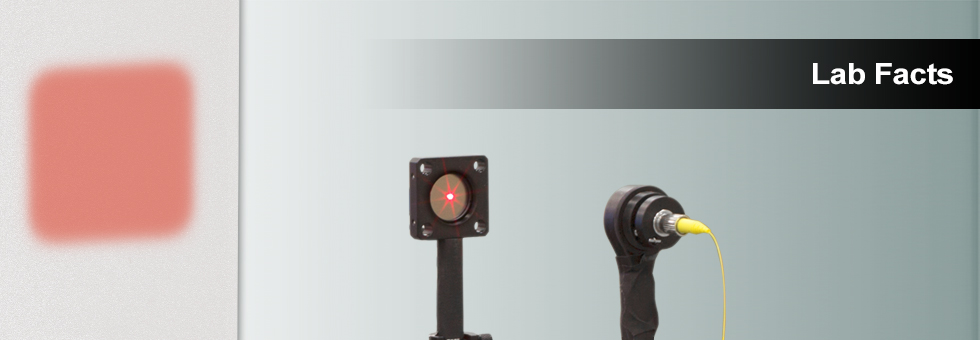

Please Wait
Introduction
Engineered Diffusers®* are designed to homogenize input beams to create non-Gaussian intensity distributions. Thorlabs offers Engineered Diffusers that provide top-hat intensity profiles in circular, square, or line distribution patterns; typical diffusers do not offer this advanced level of control over the divergence angle, spatial distribution of the illumination, and intensity profile. Polymer Engineered Diffusers are a cost-effective option and are available with circular, square, and line distribution patterns (see Polymer Diffusers tab for details). These diffusers are meant to be used in low-power applications. UV Fused Silica Engineered Diffusers are available with a circular distribution pattern (see UVFS Diffusers tab for details) and have a high damage threshold, making them ideal for high-power applications.
Please see the Technology tab for more information on the technology and fabrication of our Engineered Diffusers.
*Engineered Diffusers® is a registered trademark of VIAVI Solutions, Inc.
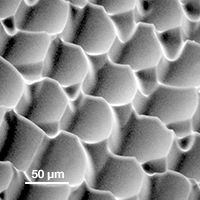
Click to Enlarge
Figure 2.2 SEM Picture of Engineered Diffuser for Display Brightness Enhancement

Click to Enlarge
Figure 2.1 SEM Picture of Engineered Diffuser for Projection Screens
Engineered Diffuser® Technology
Thorlabs' Engineered Diffusers provide advanced beam shaping that leads to significant performance enhancements for applications as diverse as lithographic systems, outdoor lighting, displays, backlighting, display brightness enhancement, and projection screens.
Homogeneous diffusers made of, for example, ground glass, opal glass, or holographic elements, consist of repeating, uniform surface patterns across the entire clear aperture that provide only limited control over the shape and intensity profile of the illuminated area, causing the incident light to be used inefficiently. In addition, holographic diffusers are usually limited to monochromatic applications using coherent light. On the other hand, Engineered Diffusers consist of differing, individually manipulated microlens units that provide broadband compatibility and excellent control over the light distribution and beam profile.
Each microlens unit that forms the diffuser is individually specified with respect to its surface profile and location in the array. At the same time, to ensure that the diffuser is stable against variations in the input beam's intensity profile and usable in the visible and IR, the distribution of microlenses is randomized according to probability distribution functions chosen to implement the desired beam shaping functions. The microlens distribution also removes zero-order bright spots and diffraction artifacts from the output. In this manner, Engineered Diffusers retain the best properties of both random and deterministic diffusers.

Click to Enlarge
Figure 2.3 Diagram of Mastering Process
Fabrication
The master microlens array is produced by a laser writing system developed by VIAVI Solutions, Inc. This system exposes a thick layer of photoresist point-by-point in a raster scan mode, as shown in Figure 2.3. By modulating the intensity of the laser beam as it is scanned, the degree to which the photoresist is exposed can be varied. A deeply textured, engineered surface is the result, as shown in the SEM images of the surface topography in Figures 2.1 and 2.2.
Comparison to Other Diffuser Technologies
Other common diffuser types include prismatic glass integrating bars, ground glass, opal glass, holographic diffusers, and diffractive diffusers. Prismatic glass integrating bars, though sometimes used in high-end systems, are expensive and occupy a great deal of precious space. Ground and opal glass scatter light equally in all directions but with a low degree of control. In addition, efficiency is generally poor with these simple diffusers. Holographic diffusers are an improvement on these technologies and enable limited production of light distribution patterns, but only offer Gaussian-like intensity profiles and circular or elliptical patterns. In terms of general beam shaping capability, diffractive elements can shape an input beam arbitrarily. However, they are confined to narrow diffusion angles, highly sensitive to wavelength, and cannot eliminate zero-order bright spots collinear with the incident beam. In contrast, Engineered Diffusers provide high transmission efficiencies and the ability to control the divergence angle, spatial distribution, and intensity profile of the diffused light.
For more information on Engineered Diffuser technology and performance, please read our Optical Diffusers Catalog Presentation.
Introduction
These Polymer Engineered Diffusers® are designed to create non-Gaussian intensity distributions in circular or square beam profiles that diverge from the plane of incidence. Figures 3.1, 3.3, 3.5, 3.7, and 3.9 show the theoretical approximations of the intensity through the center of the diverging beam profile when illuminating the engineered diffusers with a 633 nm collimated beam. Figures 3.2, 3.4, 3.6, and 3.8 show data compiled from independent tests with laser wavelengths of 488 nm, 637 nm, 785 nm, and 1064 nm to demonstrate the change in output profile with wavelength. The highlighted region of each graph denotes the divergence angle of the engineered diffuser. At the bottom of this tab is a description of the laboratory setup and procedure used to collect these data and the results.
Circular Pattern Diffusers Transmitted Intensity Plots
|
|
 Click to Enlarge Click to EnlargeFigure 3.2 Experimental Data for ED1-C20 Raw Data |
 Click to Enlarge Click to EnlargeFigure 3.3 Theoretical Data for ED1-C50 |
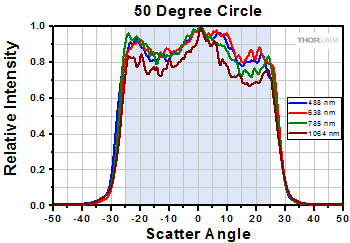 Click to Enlarge Click to EnlargeFigure 3.4 Experimental Data for ED1-C50 Raw Data |
Square Pattern Diffusers Transmitted Intensity Plots
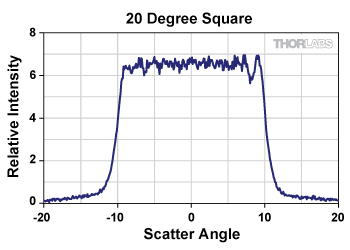 Click to Enlarge Click to EnlargeFigure 3.5 Theoretical Data for ED1-S20 |
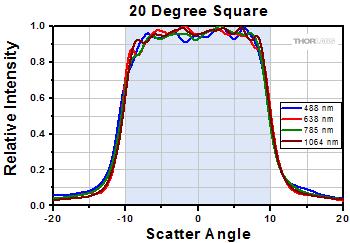 Click to Enlarge Click to EnlargeFigure 3.6 Experimental Data for ED1-S20 Raw Data |
 Click to Enlarge Click to EnlargeFigure 3.7 Theoretical Data for ED1-S50 |
 Click to Enlarge Click to EnlargeFigure 3.8 Experimental Data for ED1-S50 Raw Data |
Line Pattern Diffuser Transmitted Intensity Plot
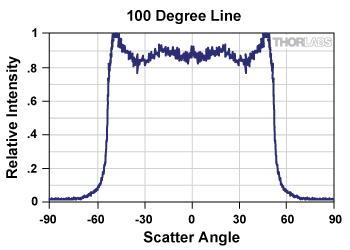
Click to Enlarge
Figure 3.9 Theoretical Data for ED1-L4100
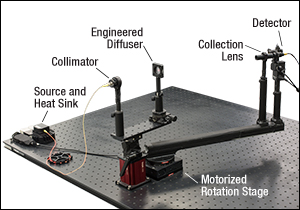
Click to Enlarge
Figure 3.10 Note: A previous-generation NR360Sa Rotation Mount was used in the above experimental set-up. High Performance Black Masking Tape was used to cover metal which might reflect laser light. A MFF101 Motorized Flipper with an empty LMR05 is not being used.
| Light Preparation | ||||
|---|---|---|---|---|
| Wavelength (nm) | 488 | 637 | 785 | 1064 |
| Source | LP488-SF20 | LP637-SF70 | LP785-SF100 | DBR1064S |
| Heat Sink | LDM9LP | LM14S2 | ||
| Collimator | TC06FC-543 | TC06FC-633 | TC06APC-780 | TC06APC-1064 |
Procedure
Four wavelengths of light were chosen for study: 488 nm, 637 nm, 785 nm, and 1064 nm. These were prepared using the equipment in Figure 3.10 (a full list of all parts used can be found under the photo of the Experimental Set Up). The optical path was approximately 35 cm above the surface of the breadboard; it began when fiber-coupled light sources were collimated with triplet collimators, using a design wavelength as close to the source wavelength as possible. In free space, the beams were incident upon one of the Polymer Engineered Diffusers. The exiting divergent profile was isolated and focused by an LA1304 plano-convex lens attached to an SM05L20 lens tube. The signal was sampled every 0.5° by a SM05PD1A photodiode. This assembly was mounted on the end of an XT34-500 rail. The opposite end of the rail was mounted to a previous-generation NR360Sa rotation stage centered with the engineered diffuser under test in order to sweep the detector and lens assembly through the center of the profile, as illustrated in Figure 3.11, and plot normalized intensity versus output angle. The distance between the diffuser and the detector was approximately 43 cm. The output angle was defined with respect to the original optical axis when the diffuser was not within the path. In order to control for ambient light, a 1 kHz sine wave was used to modulate the drive current applied to the laser diode and the signal was acquired with a lock-in amplifier. A LabVIEW program was written to control the setup and acquire the data.
Experimental Limitations
Only one of each Item # was testedb. Stability may have been compromised by the experiment being performed on a PBG11113c breadboard without any isolation. Only the middle of each diffuse shape was measured, so variances in other areas of the shape are possible, including the corners of the square profiles.
Results
It was found that there was little variance in diffuse beam profile with respect to wavelength across the middle of each beam profile. Figures 3.1, 3.3, 3.5, 3.7, and 3.9 show the theoretical estimations of intensity across the width of the resulting beam profile. Figures 3.2, 3.4, 3.6, and 3.8 show data compiled from independent tests with various laser wavelengths to verify the theoretical models.
| Item # | Theoretical | Experimental | Raw Data | |
|---|---|---|---|---|
| Circular Patterns | ED1-C20 | Click Here | ||
| ED1-C50 | Click Here | |||
| Square Patterns | ED1-S20 | Click Here | ||
| ED1-S50 | Click Here | |||
| Line Pattern | ED1-L4100 | Not Available | Not Available |

Click to Enlarge
Figure 3.11 Detector Path Through Diffuse Profiles
Figure 4.1 shows the theoretical and experimental beam profile for our EDG5C20 UV Fused Silica Engineered Diffuser®. The theoretical data is an approximation of the intensity through the center of the diverging beam profile when illuminating the diffuser with a 633 nm collimated beam, and is normalized to the relative intensity at 0°. The experimental intensity data was collected using the scatterometer set-up described below with a 635 nm collimated beam, and is an average over measurements on 20 independent diffusers with each individual measurement normalized to its 0° value. The highlighted region denotes the specified divergence angle of the diffuser, which is defined by the FWHM of the relative intensity at 0°.

Click to Enlarge
Click Here for Raw Data
Figure 4.1 The theoretical and experimental beam profile for our EDG5C20 UV Fused Silica Engineered Diffuser. The highlighted region denotes the specified divergence angle.

Click to Enlarge
Figure 4.3 A scatterometer was built to measure the scattered light from a UV Fused Silica Engineered Diffuser to characterize the beam profile.

Click to Enlarge
Figure 4.2 Illustration of the Detector Path through the Beam Profile
Experimental Procedure
A scatterometer was built to measure the scatter pattern of 635 nm laser light from a UV Fused Silica Engineered Diffuser. The experimental set-up is displayed in Figure 4.3, and a list of parts can be found below the photo. Please note that a lock-in amplifier was used in the experimental set-up but is not included in the list. The output of an S1FC635 fiber laser was collimated using an RC12FC-P01 collimator, and then a KT311 spatial filter system was used to produce a clean and spatially uniform Gaussian beam. The collimated beam was modulated using an MC2000B optical chopper synced with a lock-in amplifier and was incident upon the diffuser under test. The diffuser was mounted to a QRP02 rotation platform, which was connected to an MBR6 aluminum breadboard and attached directly to the optical table through the central aperture of an HDR50 rotation mount. An XRN25DR3 rail with an attached SM05PD3A photodiode was connected to the rotation mount, allowing the detector to sweep through the center of the diffuser's exiting divergent beam profile, as depicted in Figure 4.2. The detector was mounted approximately 13.5 cm from the diffuser, and the output angle was defined with respect to the original optical axis when the diffuser was not within the path. The detector was synced with the lock-in amplifier and signal was collected every 0.1° using a LabVIEW program for instrument control and data acquisition. The normalized intensity was plotted as a function of output angle.
Key to this experiment was the use of a spatial filter and lock-in amplifier synced with an optical chopper and photodiode detector. This configuration enabled the detection of low intensity scatter from the diffuser, providing a precise measurement of the beam profile.
| Posted Comments: | |
user
(posted 2021-10-26 00:47:39.78) hello, can the engineered diffusers be used for MCWHLP1 led source if I buy the collimation adapter SM1U25-A? soswald
(posted 2021-10-27 04:00:08.0) Dear customer,
thank you for your feedback. The engineered diffusers can be used for the beam of the MCWHLP1.
For mounting you'll need a thread adapter from the SM2 threading of SM1U25-A to the SM1 threading of the diffuser mounts, e.g. SM2A6. |
 Products Home
Products Home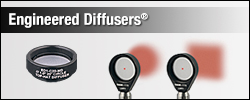
 Click to Enlarge
Click to Enlarge Engineered Diffusers
Engineered Diffusers